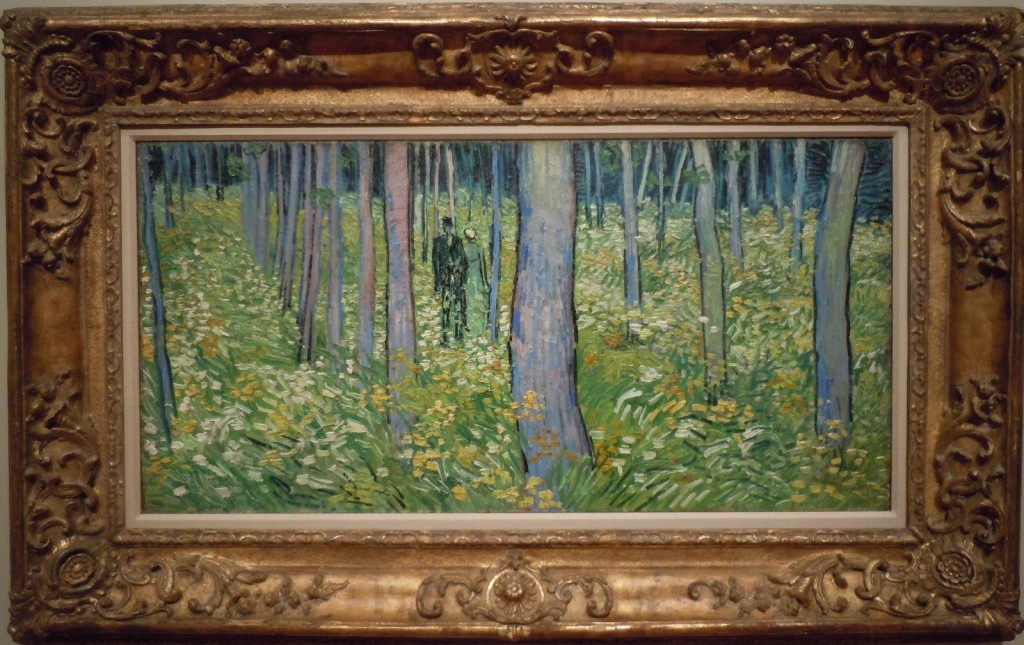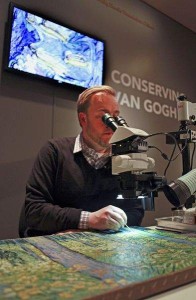
Cincinnati Art Museum is restoring Vincent van Gogh’s 1890 masterpiece “Undergrowth with Two Figures” in view of the public. At first glance the painting looks to be in good condition. The colors and contrasts appear to be strong with none of the oxidization problem that has recently been discovered as the cause of so many of Van Gogh’s light, bright yellows turning brown over time.
What’s wrong with this painting is solely the result of a 1975 restoration done by Cincinnati Art Museum conservators. They didn’t botch it, exactly. It’s just that the technique they employed, considered a best practice at the time, to keep the paint from flaking and make it less susceptible to variations in ambient temperature and humidity ends up sucking the life out of it instead. Using a wax resin, conservators affixed a second canvas to the back of the original one. Over time, that wax penetrated the canvas, collected in the brushwork crevasses and then turned from clear to milky white. That white resin coating is like a veil obscuring the bright color and textures of the painting.
 “Undergrowth with Two Figures” will be going on loan to the Philadelphia Museum of Art next year, so to stabilize it for the trip and ensure its long-term health, the Cincinnati Art Museum’s chief conservator, Per Knutas, is undertaking an in-depth restoration to remove the well-intentioned disasters of past conservators. He views the painting through a high powered microscope, and although past restorations have been done in public, this is the first time the microscope is being connected to a 42″ HDTV so that visitors to the museum can see what he sees instead of just watching a guy make tiny movements on a painting on a table.
“Undergrowth with Two Figures” will be going on loan to the Philadelphia Museum of Art next year, so to stabilize it for the trip and ensure its long-term health, the Cincinnati Art Museum’s chief conservator, Per Knutas, is undertaking an in-depth restoration to remove the well-intentioned disasters of past conservators. He views the painting through a high powered microscope, and although past restorations have been done in public, this is the first time the microscope is being connected to a 42″ HDTV so that visitors to the museum can see what he sees instead of just watching a guy make tiny movements on a painting on a table.
Knutas uses a soft brush dipped in solvent to soften the wax, then a soft bamboo stick to scrape off the wax without harming the paint.
He also will be removing varnish, a clear protective top coat, which past conservators had applied to the painting. While varnish can protect a painting, it also can alter its composition, hardening once-soft transitions and deepening colors. Research has shown that van Gogh did not varnish his paintings, Knutas said.
Watching Knutas work last week, museum director Aaron Betsky compared the painting’s amorphous, magnified forms appearing on the TV screen to contemporary video art and said it was a revelation to watch the conservation process happen.
“It’s going to make the quality of the painting come alive so much more,” he said. “One of the joys to me is when we clean our great works of art, and so much comes out that has remained hidden. It’s quite often as if you’re seeing them for the first time.”
Knutas will also take questions from museum visitors as he works. What a magnificent opportunity to see Van Gogh’s work in the minutest of detail and to learn about the art and science of conservation. For those of us outside of Cincinnati range, we must be content to see him at work in this video:
[youtube=http://www.youtube.com/watch?v=nJFlpMrY0Nw&w=430]